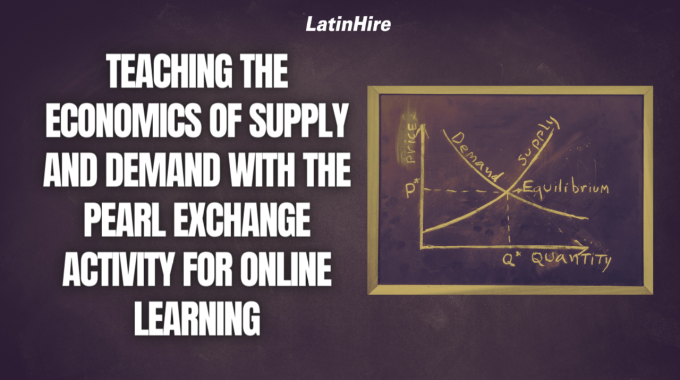In last week’s article, we looked at introducing quantum numbers using a condo analogy as…

Teaching the Economics of Supply and Demand with the Pearl Exchange Activity for Online Learning
Teaching economics concepts like supply and demand in an online class presents unique challenges. The absence of a physical classroom might seem limiting, but fear not! We have an innovative solution that brings the theory of supply and demand through an engaging online activity: The Pearl Exchange.
In this article, we will explore how virtual simulation can effectively teach students about the economic forces that govern our world, all within the digital realm.
So what is the Pearl Exchange Activity?

The Pearl Exchange Activity is a role-playing exercise designed for in-person classes to simulate a marketplace where students can exchange and purchase pearls to learn about supply and demand. This activity can be tweaked for an online learning environment by simulating a virtual marketplace where students can exchange digital pearls.
Just like in a physical classroom setting, participants are divided into two groups: sellers and buyers. Each seller is provided with a specific number of digital pearls, and each buyer is given a virtual budget to make purchases.
Supply and Demand in Action
The beauty of the Pearl Exchange Activity lies in its clear demonstration of the principles of supply and demand:
1. Scarcity and Value: With a limited number of digital pearls available, the activity immediately illustrates the concept of scarcity. Students recognize that resources are finite, leading to a better understanding of how scarcity drives value in real-world scenarios.

2. Setting Prices: Sellers set the initial prices of their digital pearls based on perceived value. As buyers interact with different sellers, they compare prices and identify the most reasonable offers. This process mirrors real-world market dynamics, where individual preferences influence pricing.
3. Equilibrium: As the activity progresses, some sellers may adjust their prices to attract more buyers, while others may raise prices due to increased demand. Through these adjustments, students witness the concept of equilibrium, where the price settles at a point that balances the number of digital pearls sellers want to sell and the number of pearls buyers are willing to purchase.

4. Shifts in Supply and Demand: Just as in a physical classroom, the facilitator can introduce virtual events that impact the supply or demand of digital pearls. These external influences showcase how real-world factors can shift the equilibrium price.
The Pearl Exchange Activity for online classes offers several benefits in teaching supply and demand in economics:
1. Interactivity: Engaging in the activity turns passive learners into active participants. This hands-on approach fosters deeper understanding and retention of the subject matter.
2. Visual Representation: The virtual simulation provides a tangible representation of abstract economics concepts, making it easier for students to grasp complex ideas.
3. Critical Thinking: As students negotiate prices and adjust strategies based on changing market conditions, they develop critical thinking skills and gain insights into decision-making processes.
4. Online Collaboration and Communication: The activity promotes online teamwork and communication as students interact with each other to achieve their individual objectives.
5. Real-World Application: By relating the virtual simulation to real-life market scenarios, students can better comprehend how supply and demand influence everyday situations.

Transitioning to an online learning environment does not need to hinder the effective teaching of economic concepts. The Pearl Exchange Activity brings the theory of supply and demand to life in the digital realm, providing students with an interactive and engaging experience.
What other interactive simulations for economics do you know for online classrooms? Share them in the comments below!



